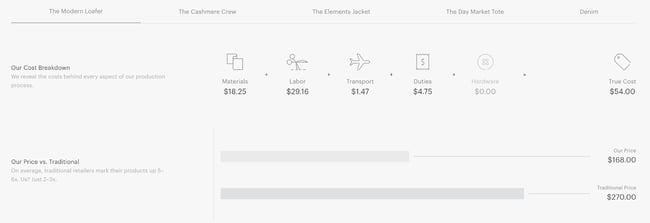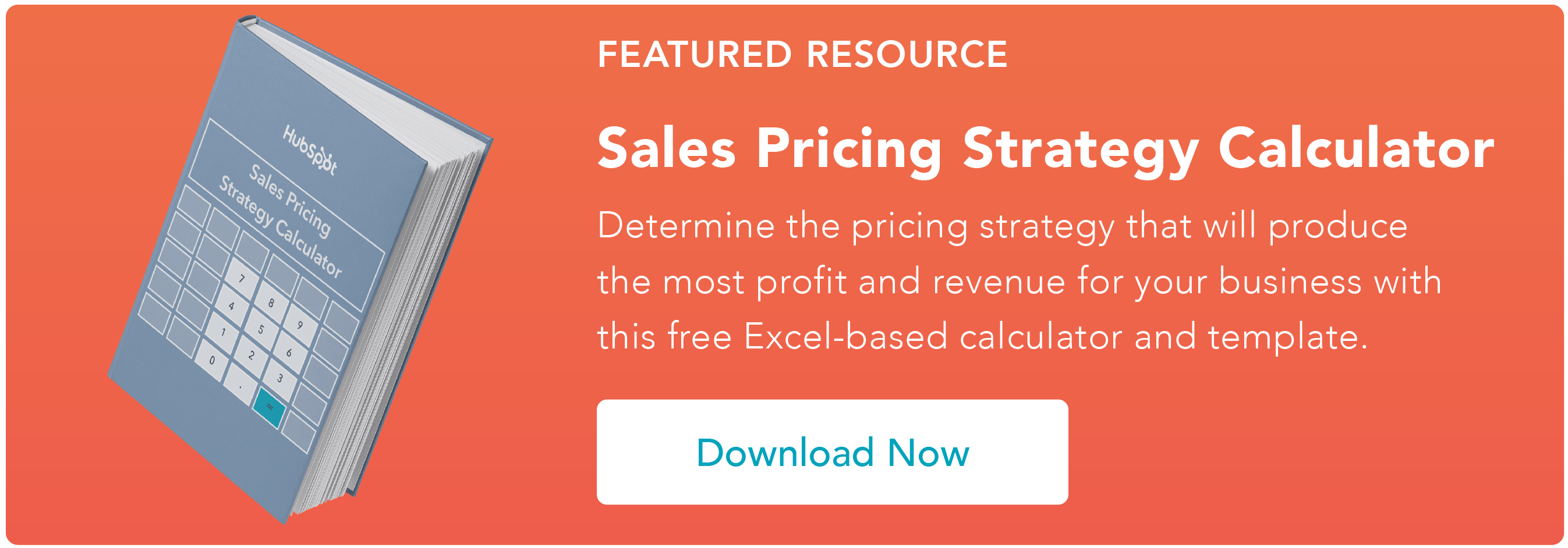Cost-based pricing is a proven strategy for generating predictable revenue. Companies use this model to improve their bottom line and differentiate themselves, and it works. For instance, Everlane uses a cost-based pricing model to differentiate itself from its competitors — and its revenue has grown year-over-year with no sign of stopping.
Download Now: Free Sales Pricing Strategy Calculator
Sometimes your pricing model can be a powerful talking point that helps salespeople generate more sales. It can be an excellent addition to your marketing verbiage, especially if others in your industry overprice their products and services.
Below, let's review the definition of a cost-based pricing strategy, the advantages and disadvantages, and the best example from a real-world brand.
What is cost-based pricing?
Cost-based pricing is a pricing method that is based on the cost of production, manufacturing, and distribution of a product. Essentially, the price of a product is determined by adding a percentage of the manufacturing costs to the selling price to make a profit. There are two types of cost-based pricing: cost-plus pricing and break-even pricing.
Cost-based pricing is one of a handful of pricing strategies, such as value-based, going-rate, or competition-based pricing.
If you do want to establish a cost-based pricing strategy, what methods do you have available, and how can you get started?
Cost-Based Pricing Strategy
Companies implement a cost-based pricing strategy to make a certain percentage more than the total cost of production and manufacturing. It’s a popular pricing choice among manufacturing organizations.
This strategy has two pricing methods: cost-plus and break-even pricing.
Cost-Plus Pricing Strategy
Cost-plus pricing is a pricing method where you add a markup to the cost of your products and services over the production and manufacturing costs.
Meredith Hart, content marketer for Owl Labs, says, "A cost-plus pricing strategy, or markup pricing strategy, is a simple pricing method where a fixed percentage is added on top of the production cost for one unit of product (unit cost)."
She adds, "This pricing strategy ignores consumer demand and competitor prices."
To calculate the cost-plus price, you'll need to add the material, labor, and overhead costs and then multiply it by (1 + the markup amount).
Break-Even Pricing Strategy
The second cost-based pricing strategy is break-even pricing or target-return pricing.
With this strategy, the price of a product is determined by the price of its manufacturing, production, and delivery without a markup. Ultimately, this strategy is used to determine how many units a company needs to sell to cover the costs of production, instead of marking up each individual unit for the purpose of generating revenue.
To calculate break-even pricing, all you need to do is divide the (fixed cost) by the (price - variable cost).
Also, if a company has a specific target return in mind, then the formula changes slightly to (fixed cost + target return) / (price - variable cost). This is the formula you'd use to figure out how many units you need to sell to make a certain return on investment.
Don’t want to calculate all of this manually? Learn how much revenue your company will generate with a cost-based pricing strategy by using this free Sales Pricing Strategy Calculator & Template.
Featured Resource: Cost-Based Pricing Calculator Template
Not sure whether cost-based pricing is right for your business? Let’s go over the advantages and disadvantages below.
Advantages of Cost-Based Pricing
Cost-based pricing is a popular pricing strategy — with good reason. Here are a few of the advantages of using a cost-based pricing model.
Easy to Calculate
Both cost-based pricing strategies — cost-plus and break-even — are appealing to companies because they're simple to understand. Simply add a markup over the cost of production, or establish a price based on the cost of production only. Regardless of the method you choose, production and overhead costs will be covered.
Ensures Profit
Cost-based pricing can also ensure a steady rate of profit. This is one of the few pricing strategies that can guarantee a profit. Regardless of the state of the industry, if you price your goods and services in relation to their production costs, you will generate revenue.
Simple for Customers to Understand
Sometimes, you might need to increase the prices of your goods and services. Most customers would be outraged by a price increase, but if you cite increasing costs of production as a reason, it’ll be much easier to defend the price increase without diving into industry jargon.
While cost-based pricing methods can be advantageous, they also have several disadvantages. Let's dive into them below.
Disadvantages of Cost-Based Pricing
Cost-based pricing is a safe pricing strategy to adopt at your company, but it’s important to be aware of the disadvantages.
Not Competition-Aware and Demand-Aware
Cost-based pricing doesn't consider demand or competition. Companies need to be aware of the overall costs to sell a product. If competitors are producing the same product for less, but sell it for the same price, those competitors will make more profits. So, to keep up, you would need to keep costs low or charge a higher price.
Results in Different Prices Compared to the Market
Usually, cost-based pricing results in drastically different prices from the market rate. This could mean that a company is selling a product with a price that's way too high or too low. If a competitor is selling at a higher price and consumers pay for that, that means customers are willing to pay that amount for a product. On the other hand, if you're charging much higher than a competitor, you'll likely get fewer customers.
Either way, you will lose profits. Since no company sells its product in a silo, it's almost always important to consider what competitors are doing.
Could Result in Manufacturing Inefficiencies
Cost-based pricing could also result in an inefficient method of manufacturing and producing a product. Any company that uses cost-based pricing won't need to consider the manufacturing process, since the cost is passed to the customer. That means that instead of streamlining production operations, companies using a cost-based strategy could inadvertently let their processes become more bloated.
Streamlining supplier and manufacturing costs is an important way that a company can
reduce costs and increase its profit margins.
Could Result in Unethical Practices
On the other hand, cost-based pricing could result in unethical production practices. If you’re trying to maximize your profits based on the cost of production, you may end up cutting corners while keeping the same markup. That’s why it’s important for cost-based providers to maintain transparency — just like Everlane does in the cost-based pricing example below.
Cost-Based Pricing Examples
Let’s take a look at two cost-based pricing examples: Everlane and a fictional attorney.
Cost-Plus Pricing Example: Everlane
As a consumer, I value transparency from companies and salespeople that I buy from. Namely, transparency in how an organization runs and how they decide the price of their products. One company I've found that does this is Everlane, an ethically sourced clothing retailer. In fact, Everlane bases its entire strategy on cost-plus pricing.
The company is marketed as radically transparent with its pricing. That means they reveal the true costs behind every product they sell — from materials to labor to transportation. Then, they disclose their price markup.
Here's an example of the calculations, right from its website:

In this example, Everlane uses the cost-plus strategy by marking up its products by two to three times the true cost. This is used as a marketing and sales tactic because traditional retailers markup products five to six times the true cost.
Break-Even Pricing Example: Attorney
In another example, let's say that an attorney wants to use the break-even cost-based pricing strategy. If that attorney calculates that the cost of running their firm is $200,000, and they charge $200 an hour, they know they need to work 1,000 hours to breakeven.
So, if the attorney wants to achieve a 20% return on their costs, they'll need to work an
additional 200 hours. A break-even pricing strategy makes it easy to calculate how much you need to work, produce, and sell to achieve a certain return.
Cost-Based Pricing Could Be the Right Strategy for You
Pricing strategies are an important part of ensuring revenue for your company. They can be used as a sales tactic for your salespeople, because your pricing strategy and transparency can even drive more sales. If implemented with strategic forethought, a cost-based pricing strategy will lead to customer trust and predictable profits, empowering you to grow your company.
Editor's note: This post was originally published in February 2020 and has been updated for comprehensiveness.
Pricing Strategy
.png?width=112&height=112&name=Image%20Hackathon%20%E2%80%93%20Vertical%20(45).png)









![Price Skimming: All You Need To Know [+ Pricing Calculator]](https://53.fs1.hubspotusercontent-na1.net/hubfs/53/price-skimming-strategy.jpg)

.jpg)
![B2B Pricing Models & Strategies [+ Pros and Cons of Each]](https://53.fs1.hubspotusercontent-na1.net/hubfs/53/b2b-pricing-models-and-strategies.jpg)